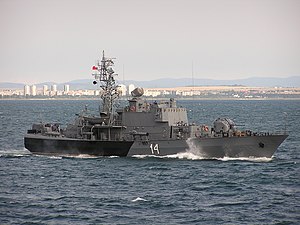This article includes a list of general references, but it lacks sufficient corresponding inline citations. (January 2013) |
 Bulgarian Navy Pauk-class corvette Bodri
| |
| Class overview | |
|---|---|
| Name | Pauk class |
| Builders | Vostochnaya Verf |
| Operators | |
| Preceded by | Poti class |
| General characteristics | |
| Type | Anti-submarine corvette |
| Displacement | 500 long tons (508 t) standard, 580 long tons (589 t) full load |
| Length | 57 m (187 ft) |
| Beam | 9.4 m (30 ft 10 in) |
| Draught | 2.4 m (7 ft 10 in) |
| Propulsion | 2 shaft M504 diesels, 20,000 shp (14,914 kW) |
| Speed | 28–34 knots (51.9 km/h/32.2 mph – 63 km/h/39.1 mph) |
| Range | 1,650 nautical miles (3,056 km; 1,899 mi) at 14 kn (25.9 km/h; 16.1 mph) |
| Complement | 40 |
| Sensors and processing systems |
|
| Electronic warfare & decoys |
|
| Armament | |
The Pauk class is the NATO reporting name for a class of small patrol corvettes built for the Soviet Navy and export customers between 1977 and 1989. The Russian designation is Project 1241.2 Molniya-2. These ships are designed for coastal patrol and inshore anti-submarine warfare. The design is the patrol version of the Tarantul class which is designated Project 1241.1, but is slightly longer and has diesel engines. The ships are fitted with a dipping sonar which is also used in Soviet helicopters.